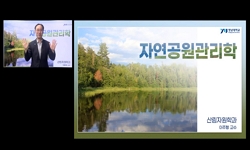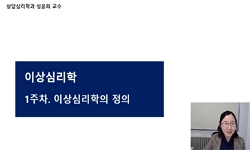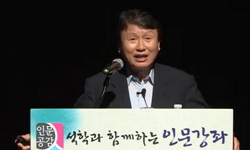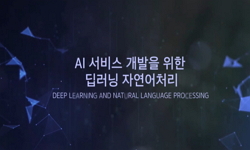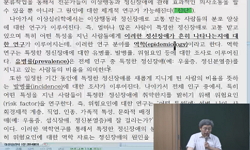본 논문은 한국 근대문학에서 ‘자연’이 연구의 사각지대에 머물렀다는 비판적 자각을 바탕으로 출발하였다. 대부분의 문학연구에서 자연은 그 역사적 기원과 이데올로기적 의도가 은폐...
http://chineseinput.net/에서 pinyin(병음)방식으로 중국어를 변환할 수 있습니다.
변환된 중국어를 복사하여 사용하시면 됩니다.
- 中文 을 입력하시려면 zhongwen을 입력하시고 space를누르시면됩니다.
- 北京 을 입력하시려면 beijing을 입력하시고 space를 누르시면 됩니다.
한국 근대문학의 자연 표상 연구 : 이상과 김유정의 문학을 중심으로 = A study on Nature represented in Korean modern literature : Focused on Yi Sang's and Kim Yu-jung's literature
한글로보기https://www.riss.kr/link?id=T12167273
- 저자
-
발행사항
서울 : 경희대학교 대학원, 2010
-
학위논문사항
학위논문(박사)-- 경희대학교 대학원 : 국어국문학과 2010. 8
-
발행연도
2010
-
작성언어
한국어
- 주제어
-
DDC
811 판사항(22)
-
발행국(도시)
서울
-
형태사항
218 p. : 삽도 ; 26 cm
-
일반주기명
경희대학교 논문은 저작권에 의해 보호받습니다.
지도교수: 김종회
참고문헌 : p. 196-212 - 소장기관
-
0
상세조회 -
0
다운로드
부가정보
국문 초록 (Abstract)
본 논문은 한국 근대문학에서 ‘자연’이 연구의 사각지대에 머물렀다는 비판적 자각을 바탕으로 출발하였다. 대부분의 문학연구에서 자연은 그 역사적 기원과 이데올로기적 의도가 은폐된 채 전통·서정·순수와 등가적인 용례로서 취급됨으로써 문학사의 통시적 흐름 혹은 시대·문화적 영향관계 속에서의 적실한 의미가 규명되지 못했다. 본 연구는 근대적 원근(遠近) 체계의 일부로서 자연을 바라본다는 기본 관점 위에서 자연 표상의 양상을 고찰하고자 했다.
구체적인 텍스트 분석에 들어가기에 앞서 본고는 Ⅱ장에서 ‘자연의 근대적 표상’이라는 논의를 원만하게 이끌 수 있는 이론적 작업을 수행하였다. 이를 위해 자연을 바라보는 몇 가지 기본 관점을 제시하였다. 첫째 ‘자연’을 물리적이고 객관적 대상을 가리키는 평면적 용어가 아니라 주관적인 인식론과 관념론의 ‘두께’를 지닌 용어로 확정했다. 둘째, 자연을 한정된 범주로써 규정하기보다 ‘인간적인 것’과의 ‘상관항’ 속에 범주화하였다. 셋째, 자연을 객관적 실체로서가 아니라 인식 주체와의 작용을 통해 구체적으로 형상화되는 ‘표상’(reprsentation)의 분석틀로 다루었다. 본고에서 다루는 표상이란 표상적 사유 뿐 아니라 동일성의 체계에 포섭될 수 없는 ‘차이’나 ‘타자’에 대한 적극적인 사유로서의 ‘비표상적 사유’를 포괄한다.
구체적으로는 철학적․ 사상적 측면과 문예사조 ․ 예술사의 측면에서 자연이 지닌 인식론의 역사를 추적하였다. 데카르트, 칸트, 헤겔의 주류 형이상학적 전통이 자연에서 정신성을 소거해 ‘물(物)’로 다루었다면, 스피노자, 셸링, 라이프니츠 등은 이원화된 자연 인식을 극복하고 ‘물(物)’과 ‘작용’을 통합해보려는 노력을 보여준다. 예술과 문예사조의 측면에서 자연 인식이 특징적으로 가시화된 것은 ‘풍경화’와 ‘낭만주의’에서이다. 낭만주의는 루소로 대표되는 ‘천진성’과 ‘소박 미학’ 즉 근원적 자연에 대한 동경과 향수에 바탕하며, 풍경화의 성립과 맥을 같이 한다. 그러나 1850년대 보들레르는 유기적 자연에 맞선 자연 적대성 혹은 인공적 세계의 비전을 작품화함으로써 자연에 기반을 둔 미학 일체를 배척하는 ‘반(反)낭만’으로서의 예술을 선언한다. 그럼에도 불구하고 자연의 ‘낭만성’은 자연을 바라보는 일종의 태도와 취향으로 굳어졌으며, 30년대 식민지 조선에서도 전통주의 담론 속에 변용되어 나타난다.
이상과 김유정 문학이 당대의 자연 담론 속에서 갖는 의미에 착목하기 위해 본고는 근대 초기 여가문화와 30년대 문학장의 ‘자연’ 양상을 고찰하였다. 경성을 중심으로 근대 문명이 전면적으로 확산되었던 30년대에 ‘자연’은 사회적 · 문학적으로 근대적 분화와 변이를 거쳐 번성하고 확산되었다. 자연은 근대적 시각 체험을 통해 ‘볼거리’ ‘풍경’, ‘완상’과 ‘감상’의 대상으로 편입되었다. 공원 · 동물원 · 식물원 · 온천 · 해수욕장 등 균질적인 공간으로 구획 · 배치되거나, 관앵 · 관화 · 순성 · 원족 · 등산 · 낚시 · 여행 · 관광 등의 문화기호로서 생산되었다. 자연의 향유는 ‘문화’ ‘오락’의 의미를 띠었으며 보다 고급화된 차원에서 감상하는 기술로서의 근대적 ‘교양’의 척도가 되었다. 문학장에서도 자연은 향토 · 고향 · 향수의 문화적 담론 형성에 필수불가결한 매개이자 낭만화된 미적 기호로서 재현되었다.
본 논문은 30년대의 문학장에서 이상과 김유정의 문학이 지닌 역동적이고 입체적인 자연 표상에 주목했다. 그들은 ‘민족’과 ‘전통’의 코드로 재현된 동시대 문학 경향에서 벗어나 근대적 풍경과 미적 대상으로 자연을 인식한다. 그것을 본고는 각각 ‘해체적 자연’과 ‘향토적 자연’으로 특징화 했다.
Ⅲ장에서 본 연구자는 이상 특유의 근대적 자연관이 자연 · 주체의 분열상을 거쳐 근대초극(近代超克)의 면모로 진행되는 양상을 보여주고자 했다. 이상은 근대 이후 전개된 자연의 위상 변화를 명료히 지각했으며 자신의 담론 속에 적극적으로 반영하였다. 자연의 정신적인 부분을 철저히 소거시킨 채 ‘물질’과 ‘수학적 계량’의 관점에서 자연의 균질화를 시도했다. 그것은 보다 급진적으로는 기존 자연과의 유기적 관계성을 상실한 인공 자연으로 ‘제작’된다. 이상의 자연은 낭만화된 ‘과거’ ‘자족성’의 기호들과 ‘조선적인 것’의 미적 전통에 침윤되어 있던 당대 자연 담론들에 대한 명백한 부정을 표명한다.
그러나 이상은 스스로 인공과 제작의 자연에 내포된 균열과 모순을 냉정하게 노출시킨다. 특히 ‘성천’(Seongcheon)은 애초에 근대적 자의식을 비춰주는 ‘거울’이었으나 그 포화된 국면으로부터 권태와 불안, 공포와 매혹이 현상되는 혼종적 텍스트로 변모한다. 자연의 과학적 읽기는 일종의 ‘오독’(誤讀)이 될 수밖에 없었으며 기꺼이 그 오독을 방법론 삼아 오독이 실패로 향하는 장면을 ‘실연(實演)’해 보여주었다. 그것은 특유의 위악, 반어, 위티즘의 수사학으로 나타난다.
이상 문학이 도달한 가장 창조적인 국면은 자연을 근대 초극의 기획으로 전유하는 장면에서이다. 이상은 경성이라는 문명 도시 혹은 근대적 세계 내부의 ‘구멍’을 발견한 자이다. 그로부터 도래한 것은 다름 아닌 전근대적 기호들이었다. 폐기되어야 할 전근대적 기호는 ‘근대의 외재화’와 ‘외부의 내재화’를 실현시키는 일종의 ‘대리보충’((supplément)으로 작용한다. 시간과 공간의 측면에서 근대 초극은 각각 ‘동력학적(動力學的) 리듬’과 ‘공지’(空地) 모티프로부터 본격화된다.
이상 문학에 근대적 주체의 ‘분열적’이고 ‘다면적’ 시선이 작용한다면, 김유정 문학에는 근대적 주체의 ‘은폐된’ 시선이 자리하고 있다. 본고는 Ⅳ장에서 김유정의 ‘향토적 자연’에 스며있는 근대성의 원리들을 밝히고 그것이 당대의 향토 담론과 어떠한 차별화를 거쳐 토착적 근대로 나아가는지 규명하고자 했다. 먼저, 김유정 문학의 자연은 그 자체의 재현이기보다 현실세계의 근대적 분화양상을 일종의 ‘담론적’ 차원에서 선취한 결과물이다. 산골, 시골, 농촌, 촌락 등의 자연공간의 명명들은 ‘도시’ 공간에 대한 대타의식을 통해 ‘반(反)도회적’ 공간으로 통합된다. 당대 농촌은 이미 농사라는 생업이 아닌 ‘황금’이라는 물신적 기호가 횡행한 곳이었다. 또한 도시에서도 자연을 통한 여가 체험은 ‘교양’이라는 당대 시민적 욕망을 창출했다.
텍스트의 내적 차원에서 김유정의 자연이 근대적 원리에 의해 구축되는 양상은 크게 세 가지 측면에서 살펴볼 수 있다. 바보형 인물은 인간에게 전이된 순진한 ‘자연’을 구현하지만 근대적 내포작가의 시선에 의해 전략적으로 특화된 자들이다. 그 연장선상에 존재하는 자연미와 순진미 역시 동시대 근대문학의 흐름 혹은 도시 · 문명의 층위로부터 ‘차이’를 확보하려는 ‘보편적 특수’로서의 근대적 미에 속한다. 이러한 경향은 김유정의 소설 언어에서도 드러나는 바, 특유의 향토색을 각인한 언어들은 전통의 계승이라기보다 오히려 세련된 조탁을 거친 근대적 산물에 가깝다.
김유정 문학은 보편적 근대에의 추구 의지를 지님에도 불구하고 궁극적으로 과거적 · 낭만적 기호로서 통용되던 당대의 향토 담론과의 명료한 차별화를 통해 자신만의 근대적 조감도를 보여준다. 김유정은 향토가 ‘생활’의 논리를 결락한 가상이라는 것을 간파했으며, 그것을 환기하고 메우는 방법으로서 ‘미’와 ‘생활’로 분화된 향토론을 제시한다. ‘생활’이야말로 김유정 문학의 주요 키워드로서, 단순히 ‘미’로 봉합될 수 없는 삶의 파열 양상을 재현함으로써 ‘토착적 근대’라는 내부적 기획을 마련할 수 있었다. 생활이 향토의 ‘공간’에 대한 재정위를 가능케 했다면, 시간적 측면에선 선조적 시간을 허물어뜨리는 ‘정열’의 역학을 통해 노스탤지어에 대한 현재적 정립을 마련하였다.
다국어 초록 (Multilingual Abstract)
This paper started on the basis of critical perception that 'nature' remains excluded from studying. In most of literature study, nature was treated as an example equivalent to tradition • lyricism • pureness, with its historical o...
This paper started on the basis of critical perception that 'nature' remains excluded from studying. In most of literature study, nature was treated as an example equivalent to tradition • lyricism • pureness, with its historical origin and ideological intent concealed, so that its exact meaning was not fully disclosed under diachronic flow of literary history or periodical • cultural influence & relation. This study is intended to examine an aspect of 'nature' from the basic viewpoint of seeing nature as a part of modern perspective system.
Before starting a concrete text analysis, this paper perform theoretical work able to progress a discussion named 'modern representation of nature' in Chapter II. For that, this paper proposed several basic standpoints. First, it definitely defined nature as a comprehensive term including subjective epistemology not as a superficial term indicating a physical and an objective subject. Second, it classified nature not into a defined category but into 'interrelationship' with 'what is humane'. Third, it did not deal with nature as objective reality but as a analytical frame of representation that concretely figures through action with the perceptive subject. The representation dealt with in this paper comprehensively includes 'non-representative thought' as a positive reason for 'a difference' or 'the other' which can't be contained in identity system as well as a representative reason.
To speak in detail, this paper tracked the history of epistemology contained in nature from the philosophical ․ ideological and literary trend ․ artistic history aspect. While the major metaphysical tradition of Descartes, Kant, and Hegel dealt with nature as 'an object' removing spirituality from it, Spinoza, Schelling, Leibniz, et al. show an effort to cope with the dualized natural perception and integrate 'an object' with 'action'. It was in 'a landscape painting' and 'romanticism' that natural recognition was remarkably visualized from the aspect of art and literary trends. Romanticism is based on 'innocence' and 'naive aesthetics' represented by Rousseau, that is, the longing and nostalgia for natural nature, and in line with establishment of a landscape. Baudelaire in 1850s, however, declares art as 'anti-romance' that excludes all the aesthetics based on nature by expressing, in his works of art, hostility towards nature that confronts organic nature or the vision of am artificial world. Nevertheless, 'a romantic disposition' of nature was established as a kind of attitude and taste of viewing nature, and is expressed as a transformed type in a 'discourse of tradition' even in the colonized country Joseon in 1930s.
To take notice of the meaning that Yi Sang's and Kim Yu-jung's literature have in the then current discourse of nature, this paper looked into the leisure culture in the early modern times and the 'nature' of literature in 1930's. The 'nature' in 1930's, when modern civilization was expanded in earnest centering on Gyeongseong, was prosperous and expanded through modern specialization and change from the social and literary aspect. Nature was incorporated as 'a spectacle', 'a landscape', 'enjoying' and 'appreciation' through modern visual experiences. It was divided or arranged as a homogeneous space such as a park •a zoo • a botanical garden • a hot spring • a beach, etc. or produced as a cultural symbol such as Kwan-eang(觀櫻) • Kwan-hwa(觀火) • Soon-sung(巡城) • Won-jok(遠足) • mountain-climbing • fishing • travel • tourism, etc. Enjoyment of nature contained a meaning of 'culture' and 'entertainment', and became a criterion of modern 'refinement' as higher-ranking appreciative skill. Even in literature space, nature re-appeared as a medium essential to formation of cultural discourse of a local area • a hometown • nostalgia and as a romanticized aesthetic symbol.
This paper took notice of the dynamic and three-dimensional 'nature' of Yi Sang's and Kim Yu-jung's literature. They, escaping from the contemporary literary trends that represented as a code of 'nation' and 'tradition', recognize nature as a modern landscape and an aesthetic subject, which were respectively characterized as 'de-constructive nature' and 'local nature'.
In Chapter Ⅲ, the author tried to show an aspect in which Yi Sang's peculiar modern natural viewpoint proceeds into a shape of overcoming modernity via a separative phase of nature • the subject. Yi Sang clearly realized a change of the nature's position developed after the modern times, and positively reflected such a change in his own discussions. Thoroughly removing the spirituality of nature, he attempted homogenizing nature from the viewpoint of 'substance' and 'mathematical measuring'. It is urgently manufactured as artificial nature that lost organic relationship with existing nature. Yi Sang's nature represents a clear negation against the then current natural discussions that were saturated with symbol of romanticized 'past' 'self-sufficiency' and the aesthetic tradition of 'Joseon's things'. But, Yi Sang for himself calmly exposes the break and contradiction contained in artificial and manufactural nature. Especially 'Seongcheon' was originally a mirror reflecting modern self-consciousness, and is transformed into mixed texts emitting boredom and anxiety, horror and attraction. Scientific reading of nature was forced to become a kind of 'mis-reading' and actually performed the scene that such mis-reading goes towards a failure, willing to set it as methodology. This is represented as rhetoric of peculiar dysphemism, an irony and wittism.
The most creative aspect Yi Sang literature reached is a scene that exclusively uses nature as planning of overcoming modernity. Yi Sang discovered 'a hole' of the inside of a civilized city named Gyeongseong or modern world. It was the very premodern symbol that was derived from 'a hole'. The premodern symbol that need to be repealed act as a kind of 'supplement'. Overcoming modernity, from the aspect of time and space, respectively starts in earnest from 'a dynamic rhythm' and a 'vacant space' motif.
If the 'separative' and 'many-sided' glances of the modern subject act on Yi Sang's literature, it can be said that 'concealed' glances of the modern subject lie with Kim Yu-jung's literature. This paper, in Chapter IV, aimed to disclose principles of modernity filtered into Kim Yu-jung's local nature and to examine how it proceeds into native modernity through what kind of differentiation and contemporary local discourse. First of all, nature of Kim Yu-jung's literature is a result of modern divergence of the reality in advance obtained from a kind of 'discussion-related dimension'. The nominations of natural spaces such as a mountain district, a country, a farm village, a hamlet, etc. are integrated as an 'anti-urban' space through substitute consciousness against an 'urban' space. The contemporary farm villages were the place where not agriculture as their lives' work but materialistic symbol named 'gold' were widely spread. Also, even in cities, leisure experiences of nature created the then current civil desire named 'refinement'.
The phase in which Kim Yu-jung's nature is built by modern principles from the internal dimension of text can be largely looked into from three aspects. 'A fool-type human being' embodies pure 'nature' transmitted to the human being, but they are the persons strategically specialized by glances of modern 'implied author'. 'The natural and pure beauty' existing in the extension is also included in modern beauty as 'universal singularity' that intends to secure 'differences' from the flow of modern literature or a layer of city • civilization. Such a trend is showed even in Kim Yu-jung's novelistic language, and 'the languages' stamped by inherent local tints are close to modern products that underwent polished carving rather than succession to tradition.
Kim Yu-jung's literature, regardless of its having the will to pursue universal modernity, have modern gaze of his own through clear differentiation with the then current local discourse widely accepted as romantic tastes. Kim Yu-jung realized that locality was an imagine which removed logic of 'the living', and as a means of arousing and supplementing it, proposes the local discourse which was divided into 'beauty' and 'the living'. 'The living' itself is the key word of Kim Yu-jung's literature, and Kim Yu-jung could prepare internal planning of 'native modernity' by representing the life-breaking phase to be not sutured only with 'beauty'. Supposing that the living enabled re-location of a rural space, present establishment for nostalgia through dynamics of 'passion' that tears down linear time from the temporal aspect was prepared.
This study has a significance in several points. First, it ascertained the secretly related areas between nature and modernity, and, through this, revealed the characteristics of modern literature. Second, by reading modernism novels in 1930s, dealt with as a product of urban experiences, through nature, the 'externalized inside', it was able to glaze exactly the desire and breaking phase of the modern. Third, it created re-consideration effects on dominating viewpoints of seeing Yi Sang's and Kim Yu-jung's literature. However, it remains as a limit to this study that it failed to comprehensively outline the general aspect of 'nature' through close relation with other modernism works or contemporary other schools such as KAPF or Life Group(生命派), etc. This point is expected to be supplemented in the next studies.
목차 (Table of Contents)
- Ⅰ. 서론 1
- 1. 연구 목적 1
- 2. 연구사 검토 5
- 3. 연구 방법 및 범위 17
- Ⅱ. 자연의 근대적 표상에 대한 이론적 고찰 23
- Ⅰ. 서론 1
- 1. 연구 목적 1
- 2. 연구사 검토 5
- 3. 연구 방법 및 범위 17
- Ⅱ. 자연의 근대적 표상에 대한 이론적 고찰 23
- 1. 자연의 개념과 인식론의 역사 23
- 2. 근대적 표상이론의 전개 33
- 3. 자연의 근대적 표상 37
- Ⅲ. 해체적 자연과 다면적 주체 : 이상 49
- 1. 인공 제작의 자연 50
- 가. 과학적 해석의 모델 50
- 나. 자연의 인공화와 인공적 자연 58
- 다. 반전통 반낭만의 기호 64
- 2. 다면적 시선의 분열성 72
- 가. 성천 체험 : 인외경(人外景)의 권태와 문명의 불안 72
- 나. 방법으로서의 오독 : 근대적 가면의 위티즘 80
- 다. 건강과 위생의 패러독스 85
- 3. 자연-문명의 변증법과 근대초극 95
- 가. 전근대적 기호의 대리보충 96
- 나. 아침오후두시와 모호리-나기 : 동력학적 시간의 저항성 106
- 다. 공지(空地)와 자궁-건축 : 반소유적 문명 공간의 생명성 114
- Ⅳ. 향토적 자연과 은폐된 주체 - 김유정 122
- 1. 담론적 구성으로서의 자연 122
- 가. 1930년대 자연공간의 반도회적 통합 123
- 나. 금밭/콩밭 : 황금이라는 물신적 기호 131
- 다. 교양이라는 시민적 욕망 139
- 2. 은폐된 시선의 통어력(統御力) 143
- 가. 협소한 인물형 : 근대적 내포작가와 특화된 상상력 144
- 나. 보편적 특수로서의 자연미 순진미 151
- 다. 언어의 세련된 조탁과 향토색의 발명 157
- 3. 향토 담론의 전유와 토착적 근대 164
- 가. 향토의 재현 : 미와 생활로의 분화 164
- 나. 마주보는 향토담론과 도시담론 172
- 다. 조선-자연-과거의 현재적 정립과 정열의 역학 176
- Ⅴ. 이상과 김유정 문학의 자연 표상 비교 184
- Ⅵ. 결론 190
- 참고문헌 196
- Abstract 213





